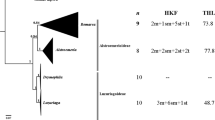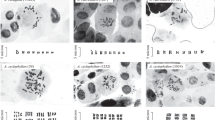Abstract
Chromosome numbers, mainly gametic, are given for 28 populations belonging to 13 species in ser.Ceratophyllae as circumscribed byWebb & Gornall. From a cytological point of view, we report or confirm the occurrence of aneuploidy in at least 8 of the 19 species recognized. This phenomenon, together with the technical difficulties inherent to the genus, is responsible for a number of incorrect or imprecise previous reports which are here questioned. Aneuploidy and the karyological instability behind it apparently reflect very active extant processes which might play an important role in the evolution of the group. Cytological and morphological data allow the recognition of four groups; one of them is likely to constitute a monophylectic group (ser.Ceratophyllae sensu stricto) but, the monophyly of the seriesCeratophyllae sensu lato is questioned.
Similar content being viewed by others
References
Böcher, T. W., 1983: The allotetraploidSaxifraga nathorstii and its probable progenitorsS. aizoides andS. oppositifolia. — Medd. Gronland11: 1–22.
Contandriopoulos, J., 1962: Recherches sur la flore endémique de la Corse et sur ses origines. — Thesis, University of Montpellier.
Dalgaard, V., 1991: Chromosome studies in flowering plants from Macoronesia II. — Willdenowia20: 139–151.
Damboldt, J., 1968: Zur Cytotaxonomie der GattungSaxifraga L. III. — Ber. Deutsch. Bot. Ges.81: 43–52.
, 1971: Zur Cytotaxonomie der GattungSaxifraga L. IV. Weitere Untersuchungen in derSaxifraga exarato-moschata Gruppe. — Ber. Deutsch. Bot. Ges.84: 705–712.
, 1965: Zytotaxonomische Untersuchungen anSaxifraga-Sippen der grexExarato-moschatae Engl. & Irmscher. — Ber. Deutsch. Bot. Ges.77. 332–339.
Delay, J., Vivant, J., 1978: Sur quelques endémiques pyrénéennes Cytotaxonomie (1apartie). — Bull. Soc. Bot. France125: 485–492.
Engler, H. G. A., Irmscher, E., 1916:Saxifragaceae: Saxifraga. — InEngler, H. G. A, (Ed.): Das Pflanzenreich67: 1–448. — Leipzig: Engelmann.
Ehrendorfer, F., 1949: Zur Phylogenie der GattungGalium. I. — Österr. Bot. Z.96: 109–138.
, 1963: Cytologie, Taxonomie und Evolution bei Samenpflanzen. — Vistas Bot.4: 99–186.
Favarger, C., 1965: Notes de caryologie alpine, IV. — Bull. Soc. Neuchâteloise Sci. Nat.88: 15–23.
, 1967: Cytologie et distribution des plantes. — Biol. Rev.42: 163–206.
, 1964. — InLöve, A., (Ed.): IOPB chromosome number reports II. — Taxon13: 201–209.
, 1968: Contribution á la cytotaxinomie de la flore alpine des Pyrénées. — Collect. Bot. (Barcelona)7: 325–352.
, 1970: Dysploïdie et chromosomes surnuméraires dans l'espèce collectiveCarduus defloratus L. agg. — Bull. Soc. Bot. Suisse80: 269–288.
Fedorov, A., 1974: Chromosome numbers of flowering plants. — Koenigstein: Koeltz.
Fernández Casas, J., 1975. — InLöve, A., (Ed.): IOPB chromosome number reports XLVII. — Taxon24: 144–145.
Galland, N., 1990: Recherche sur l'origine de la Flore orophile du Maroc: etude cyryologique et cytogeographique. — Rabat: Institut Scientifique.
Hamel, J. L., 1953: Contribution à l'étude cytotaxinomique des Saxifragacées. — Rev. Cyt. Biol. Vég.14: 113–313.
, 1954: Matériaux pour l'étude caryo-taxonomique des Saxifragacées. 1. Huit Saxifrages de la SectionDactylites Tausch, diteDactyloides Tausch. — Mém. Soc. Bot. France1954: 106–121.
Jackson, R. C., Casey, C., 1980. — InLewis, W. H., (Ed.): Polyploidy. — New York: Plenum Press.
Knaben, G., 1954:Saxifraga osloensis n. sp., a tetraploid Species of theTridactylites section. — Nytt Mag. Bot.3: 117–138.
Küpfer, P., 1971: Liens génétiques entre les flores alpinenne et pyrénéenne. — Ann. Litt. Univ. Besançon21: 167–185.
, 1972: Sur deux espéces orophiles intéressantes des Abruzzes:Saxifraga italica D. A. Webb etPtilotrichum rupestre (Temora)Boissier subsp.rupestre. — Bull. Soc. Neuchâteloise Sci. Nat.95: 43–55.
, 1983: Index des nombres chromosomiques des Spermatophytes de la Suisse I.Saxifragaceae. — Bot. Helvetica93: 11–25.
Löve, A., Löve, D., 1961: Chromosome numbers of central and northwest European plant species. — Opera Bot.5: 1–581.
Moore, D. M., 1982: Flora Europaea. Check-list and chromosome index. — Cambridge: Cambridge University Press.
Ortega, J., Navarro, B., 1977: Estudios en la Flora Macaronésica: algunos números de cromosomas. IV. — Bot. Macar.4: 69–76.
Parker, J. S., Jones, G. H., Edgar, L., Whitehouse, C., 1989: The population cytogenetics ofCrepis capillaris. II. The stability and inheritance of B-chromosomes. — Heredity63: 19–27.
Redondo, N., Horjales, M., 1989: Datos cariológicos del géneroSaxifraga L. en el NW Ibérico. — Bol. Soc. Brot. Sér. 2,62: 195–203.
Schoennagel, E., 1931: Chromosomenzahl und Phylogenie der Saxifragaceen. — Bot. Jahrb. Syst.23: 266–308.
Skovsted, A., 1934: Cytological studies in the tribeSaxifragaceae. — Dansk Bot. Ark.8: 1–52.
Soltis, D. E., 1983: Supernumerary chromosomes inSaxifraga virginiensis (Saxifragaceae). — Amer. J. Bot.70: 1007–1010.
Stebbins, G. L., 1971: Chromosomal evolution in higher plants. — London: Edward Arnold.
Vargas, P., 1987:Saxifraga ×davidis-webbii, híbrido nuevo, y precisiones sobre la distribución de uno de sus progenitores (S. moncayensis D. A. Webb). — Anales Jard. Bot. Madrid44: 540–542.
, 1991: On the vegetative and floral development inSaxifraga ser.Ceratophyllae and ser.Pentadactylis (Saxifragaceae). — Taxon40: 41–43.
, 1994: Estudios biosistemáticos en el géneroSaxifraga: serie (Ceratophyllae (s.l.) — Ined. Doctoral Dissertation. Universidad Complutense, Madrid.
, 1988: Consideraciones taxonómicas acerca deSaxifraga losae Sennen y sus relaciones conS. pentadactylis Lapeyr. — Anales Jard. Bot. Madrid45: 121–133.
Vivant, J., Delay, J., 1980: Sur quelques endémiques pyrénéennes. Cytotaxonomie (2e partie). — Bull Soc. Bot. France127: 493–505.
Villa, R., 1978: Numeri cromosomici per la Flora Italiana. — Inf. Bot. Ital.10: 241–248.
Webb, D. A., 1987: Taxonomic and nomenclatural notes onSaxifraga L. — Bot. J. Linn. Soc.95: 227–257.
, 1989: Saxifrages of Europe. — London: Christopher Helm.
Zhukova, P. G., Petrovsky, V. V., 1987: Karyotaxonomic study of some species of the genusSaxifraga (Saxifragaceae) from northern Asia. — Bot. Ž.72: 632–640.
Author information
Authors and Affiliations
Rights and permissions
About this article
Cite this article
Vargas, P., Feliner, G.N. Cytotaxonomical study ofSaxifraga seriesCeratophyllae s.l. (Saxifragaceae). Pl Syst Evol 197, 209–223 (1995). https://doi.org/10.1007/BF00984640
Received:
Accepted:
Issue Date:
DOI: https://doi.org/10.1007/BF00984640




